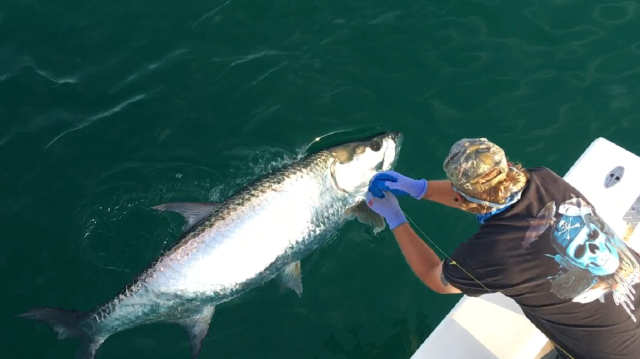The cure for tarpon fever — go out and catch one.
The tarpon fever epidemic is rapidly spreading throughout the small barrier island of Anna Maria.
Local fishers as well as fishers around the world are experiencing sleepless nights due to the intoxicating anticipation of doing battle with the elusive silver king.
Other symptoms of “tarponitis” include spending vast amounts of money on the proper tackle and ample amounts of bait, and then, calling in “sick” because the bite is on. Also, sunstroke and fatigue due to endless hours of patrolling the waters in search of fish are very common. And forget about those weekend family outings for the next two months, that is, unless the family is going out tarpon fishing, too.
Yeah, I guess tarpon just have that effect on people. Think about seeing a 7-foot long fish come skyrocketing out of the water, head shaking frantically to spit the hook before landing and then dumping your spool before you even knew what happened. Sound appealing? You betcha.
Now, I must warn you, tarpon fishing requires some physical endurance. If your work out program mainly consists of 12-ounce curls, you may find yourself second-guessing your choice of targeted species after an hour behind the reel. But, if you’re lucky enough to actually land the fish, the memory will be forever fixed in your mind. That’s where it all starts. You’ve been exposed to the epidemic known as “tarponitis.”
On my own excursions on Just Reel fishing charters my clients are I are ailing from tarpon fever. The early morning bite just prior to sunrise is producing the best action for me and my clients. Multiple hookups are occurring in the dark on live crabs cast directly into the schooling fish. As the sun rises and the abundance of boats becomes unbearable. I’m cruising the beaches in search of “less stressed” fish. Casting crabs or threadfin herring to these fish is resulting in a hook up or two.
For those not exposed to the tarpon fever, the backcountry is still producing plenty of catch-and-release snook. Rallies of 20 fish or more are occurring during the maximum flow of the incoming tide. Live shiners are a favorite for bait.
The same applies for spotted seatrout. Deep grass flats are host to numerous trout as well as Spanish mackerel, ladyfish and bluefish. This scenario is great for visiting tourists who want a lot of action but also want a few fish — the trout — to take home for a meal.

